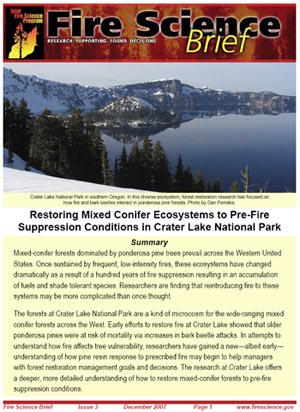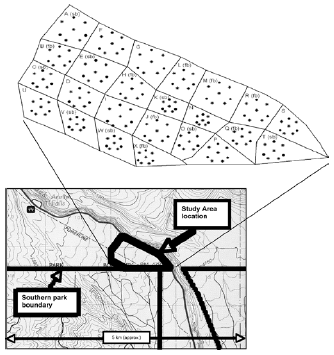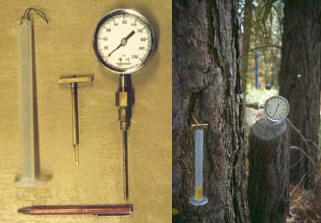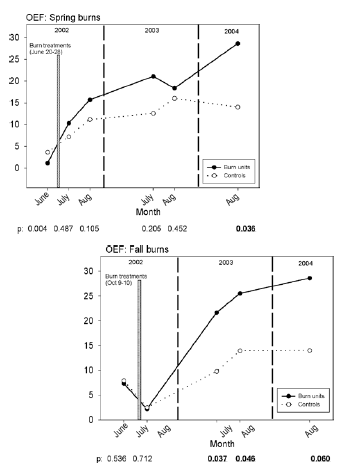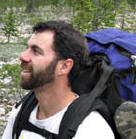Restoring Mixed Conifer Ecosystems to Pre-Fire Suppression Conditions in Crater Lake National Park by James Agee and Dan Perrakis
Complete Report (PDF file)
restoring-mixed-conifer-ecosystems
Summary
Mixed-conifer forests dominated by ponderosa pine trees prevail across the Western United States. Once sustained by frequent, low-intensity fires, these ecosystems have changed dramatically as a result of a hundred years of fire suppression resulting in an accumulation of fuels and shade tolerant species. Researchers are finding that reintroducing fire to these systems may be more complicated than once thought.
| Key Findings |
- In the mixed-conifer forest at Crater Lake, fall burns were more effective at removing fuels and reducing wildfire risk than spring burns.
- In the old growth ponderosa pine stands at Crater Lake, entire age class cohorts of ponderosa pines were absent as a result of an era of fire suppression.
- Older ponderosa pines were at greater risk of mortality after fire treatments, largely as a result of their increased vulnerability to beetle attack.
- Resin response increased in burned trees as compared to control trees. But resin response was not correlated with beetle susceptibility.
The forests at Crater Lake National Park are a kind of microcosm for the wide-ranging mixed conifer forests across the West. Early efforts to restore fire at Crater Lake showed that older ponderosa pines were at risk of mortality via increases in bark beetle attacks. In attempts to understand how fire affects tree vulnerability, researchers have gained a new—albeit early—understanding of how pine resin response to prescribed fire may begin to help managers with forest restoration management goals and decisions. The research at Crater Lake offers a deeper, more detailed understanding of how to restore mixed-conifer forests to pre-fire suppression conditions.
Crater Lake National Park in southern Oregon is home to mixed-conifer stands characteristic in age and structure to ponderosa pine forests found all over the West. Now, in large part because of an era of fire suppression, the Crater Lake old-growth pine groves—like many other such stands—are suffering from an influx of shade-tolerant white fir and other species. The National Park Service began work to restore more natural structure to the forests of Crater Lake as early as the mid-1970s.
But as with all dynamic and complex systems, sometimes things may not be as simple as expected. After a decade of experimental burning at Crater Lake, researchers found an irksome result. Trees in the largest size classes in experimental burn areas saw higher mortality over time than those in control plots. This was contrary to the restoration goal of using fire to reduce fuel load, while preserving larger trees. It turns out that some large, fire-damaged pines became susceptible to bark beetle attacks, which often would lead to tree death.
Jim Agee, a forest ecologist at the University of Washington, was one of the first to sound the alert on bark beetles. He says, “Many forest restoration projects across the West have as a primary objective the protection of large, old ponderosa pines. If, in the process of restoration, we are inadvertently causing their death, then this is clearly not meeting our objective.”
Agee says that with those first reports in the mid-1980s, bark beetles (especially the western pine beetle, Dendroctonus brevicomis) quickly came into the spotlight as potential players in any possible restoration effort geared to mixed-conifer ponderosa pine stands. The Crater Lake microcosm seemed the ideal model system to explore a realistic and effective understanding of how to restore mixed-conifer ecosystems. Indeed, research at Crater Lake has opened a vital new realm of research on the ways beetles interact with fire management and restoration goals across the West. Because, says Agee, “The intent is to understand the mechanism of tree death after prescribed fire and to somehow circumvent that mechanism.”
Of Beetles and Pine Resin: New Players in Understanding Forest Restoration
Once the Agee team knew prescribed fire triggered vulnerability to beetle attacks in the largest pines, they saw how critical it would be to understand more about how and why the beetles affected burned trees. Prescribed fire is now common practice in mixed conifer stands across the West, and until Agee’s early findings were released, few realized that beetle-induced mortality could be a central factor in mixed-conifer forest restoration.
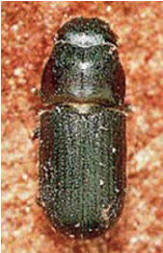 |
| Western pine beetle. Photo from USDA Forest Service, Pacific Southwest Research Station. |
Dan Perrakis saw the value of the Crater Lake ecosystem as a place to reveal the inner workings of the tree/fire/beetle interplay. Perrakis, Agee’s doctoral student, set about not only to evaluate how prescribed fire affected restoration goals, but also to understand pine tree susceptibility to beetle attack and the biological reasons why trees would experience beetle-induced mortality after prescribed fire.
According to Perrakis, “Part of the long-term benefit of this study is to get a better handle on mechanisms of mortality. Managers can then tailor their tools (prescribed fire or other treatments) based on their desired objectives. It is much more useful to understand why some fires kill trees and others do not, or why some physiological conditions lead to bark beetle attacks, than to merely note that trees are sometimes killed by restoration treatments. This study is part of the process of refining our understanding and improving our available tools.”
So, in addition to measuring the effects of prescribed burns on fuel and forest structure and ponderosa pine mortality, Perrakis and Agee also measured ponderosa pine resin defenses. When beetles attack a tree, one biological response is for the tree to defend itself against invasion by swamping or ejecting the insect with pine resin (also known as oleoresin). The team wondered whether the flow of resin or pressure of resin was affected by burn injury to the trees (as some previous evidence suggested was possible), and if so, how that could impact vulnerability to beetle attack.
Agee explains, “We know that increased resin flow is associated with better defense against beetles, and that prescribed fire increases resin flow. However, most studies have looked at only short-term resin flow, and the fact that large, old trees are dying some years after fire (not always, but sometimes) suggests that initial increases in resin flow may not be maintained.”
What’s more, adds Perrakis, until now, there has been a paucity of information on tree response. “Beetle information helps us understand a pathogen, while resin information helps us understand the line of defense against it. A number of studies, including this one, have identified bark beetles to be the most significant single cause of mortality amongst these large trees after restoration. A few studies had looked at the topic from the beetle perspective, so there was a clear need to examine the effects on the trees themselves.”
Burning Answers
As for the burn objectives, Perrakis and Agee wanted to see how prescribed fire in their study stood up to overarching restoration goals for mixed-conifer stands in general. With both a fall and spring burn program in place, the study offers valuable and novel information that Perrakis hopes will help managers conserve old-growth ponderosa pines. “As land managers attempt to restore fire into ecosystems where it was once common, challenges such as bark beetle attacks can make the task very difficult, and managers will need many different management tools and techniques. Understanding how fire can affect bark beetle response is a valuable piece of the puzzle.”
The study area is located on a 150-acre parcel at Crater Lake National Park that includes old growth mixed-conifer forest that has been protected from fire since 1902. Study plots were 5–6 acres each, and were randomly assigned the treatments: spring burn, fall burn, or control. There were 24 plots total, with 8 plots for each of the three treatment types. The team measured fuel and forest structure, ponderosa pine mortality, and ponderosa pine resin defenses. To measure resin defenses, the scientists captured information on both oleoresin exudation pressure (OEP) and oleoresin flow (OEF). OEP gives information on the pressure of resin within the sapwood, while OEF is simply a measure of resin flow out of a hole in the tree. Scientists measured post-fire responses for nearly 2 years starting in 2002.
The scientists found that fall burns far outpaced spring burns for so-called “burning effectiveness.” While both burn seasons reduced fuels, killed small trees, and generally lowered fuel loads, the fall burns were “considerably more intense and had much higher coverage than the spring burns,” according to Perrakis. Fall burns in this particular study met known thresholds for burning effectiveness, with burn coverages averaging 76 percent of the treated units. Fall burns also reduced total dead fuels by almost 52 percent versus about 18 percent for spring burns. In comparing their data with similar research, Perrakis and Agee say that the fall burns in this system are likely to be very effective at reducing the risk of stand-replacing wildfire, while spring burns may be much less effective.
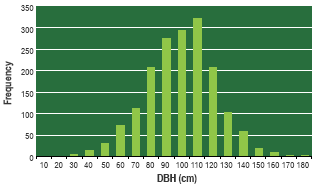 |
| Size-class distribution of ponderosa pines in the study area. (From D.D.B. Perrakis, 2004.) |
Still, prescribed burning and effectiveness do not necessarily equate with restoration if recreating “pre-fire suppression conditions” is the goal. Consider that in the entire study area, the researchers found almost no pine trees in the <20 cm DBH (diameter breast height) size class. In other words, pine recruits to this population are essentially non-existent.
Perrakis and Agee published this work in a recent paper called “Seasonal fire effects on mixed-conifer forest structure and ponderosa pine resin properties,” in the Canadian Journal of Forest Research. They write,: “While prescribed fire in these stands may generally be successful in achieving structural objectives (opening the canopy and reducing encroaching tree density), the consequences of the fire suppression legacy include a century of missing ponderosa pine age class cohorts. These structural elements will remain absent from the stand for decades while remaining old-growth pines continue to decline.”
What’s more, says Perrakis, “The fire-beetle research at Crater Lake has shown that these old trees are currently in a very fragile state due to fire suppression conditions, and restoration efforts will need to proceed cautiously and patiently to succeed.”
Go With the Flow: Does Post-Fire Resin Response Help Explain Tree Death?
Outfitted with their ingenious resin flow and pressure equipment and measurement techniques, Perrakis and Agee found new, albeit unexpected ways to understand ponderosa pine mortality after fire treatments. Besides very obvious visual signs linking fire to western pine beetle attacks, the researchers were surprised to see that there was no evidence for reduced resin defenses in burned trees. At least for the 2 year duration of their study, lack of resin defense could not explain why trees succumbed to beetle attacks.
“One of the more important take-home messages from this project was that post-fire resin flow was not indicative of survival rate,” explains Perrakis, “Although measuring resin properties is not a widespread management tool, it was previously believed that more resin flow meant universally greater defenses. We showed that the story is more complicated than that by exposing some erroneous assumptions.”
In this study, at least, resin properties did not correlate with pine mortality. “So,” explains Agee, “the increased mortality due to restoration (burning) is likely site or time dependent. The issue is complex, but the hope is that we can continue restoration efforts with less effects on older ponderosa pines if we better understand the beetle defense systems these trees possess.”
But resin defenses did increase in burned trees in comparison with control trees. So, the researchers suspect there could be a link between resin defense and beetle activity—perhaps by way of fire-induced chemical cues that beetles use to locate injured trees. They write in the publication cited previously, “Further research examining the role of fire in initiating primary attraction and the relative effects of different types or intensities of fire would help answer this question.”
Resin response and how it is (or isn’t) linked to pine tree susceptibility to beetle attacks, is akin to finding a missing piece to an incomplete puzzle. If old growth ponderosa pine trees die after “restoration” treatments designed to bolster their vigor, then the restoration goal has not worked. Given the growing understanding of the relationship between tree vulnerability to beetles, prescribed fires, and old trees, any attempt to clarify how resin response affects trees adds more biological effectiveness to restoration goals.
Perrakis and Agee continue to explore how resin response is affected by fire, and how that in turn affects tree growth. They are now working to monitor resin response to a host of different kinds of tree injury, including pruning and scorching, both the root system and the crown and branches. They will monitor which treatments are associated with more or less tree growth, and which are associated with more or less resin response.
Agee is enthused about the resin response research. “We have the longest record of resin flow data collection that I am aware of. We also developed a technique to allow repeated measurements of the same trees in a nondestructive manner.”
Most important, the puzzle piece symbolized by understanding more about resin response, and all it entails, lends managers and planners yet another vital piece of information for effective forest restoration. As Agee points out, “It is important to be able to achieve management objectives, and this research is intended to improve the efficacy of restoration treatments.”
Dan Perrakis concludes, “These are magnificent old creatures—they have been around hundreds of years, and we have put them at risk by taking fire out of the ecosystem in the 20th century. It is critical that when we reintroduce fire into the ecosystem, we do so in a way that best preserves these magnificent old ‘yellow belly’ pines. Obviously, they will not live forever, but we do not want to hasten their demise.”
Management Implications
- The mixed-conifer forest at Crater Lake National Park represents similar, ponderosa pine ecosystems across the West. As such, results and understanding from Crater Lake may apply to many other areas.
- Recent data on the importance of resin response to burned trees—and how they may or may not be affected in terms of beetle susceptibility—underscores the value of measuring and understanding tree physiology in response to injury. New techniques are now documented to help understand resin response in ponderosa pine trees.
- If the goal of forest restoration includes the preservation of large, old growth ponderosa pine trees, it is critical for managers and planners to have more effective tools as evidence emerges on the possible susceptibility of fire-treated pine trees to beetle attack. In addition, it is imperative to have this understanding given the lack of young pine recruits in the understory of fire-suppressed stands. Further Information: Publications and Web Resources
Agee, J.K. 1993. Fire ecology of Pacific Northwest forests. Island Press, Washington, DC.
Agee, J.K. 2003. Historical range of variability in eastern Cascades forests, Washington, USA. Landsc. Ecol. 18: 725-740.
Covington, W.W. and M.M. Moore. 1994. Southwestern ponderosa pine forest structure: changes since Euro-American settlement. J. For. 92(1): 39-47.
Feeney, S.R., T.E. Kolb, W.W. Covington, and M.R. Wagner. 1998. Influence of thinning and burning restoration treatments on presettlement ponderosa pines at the Gus Pearson Natural Area. Can. J. For. Res. 28:1295-1306 (http://cjfr.nrc.ca).
Fulé, P.Z., A.E.M. Waltz, W.W. Covington, and T.A. Heinlein. 2001. Measuring forest restoration effectiveness in reducing hazardous fuels. J. For. 99(11): 24-29.
Kolb, T.E., K.M. Holmberg, M.R. Wagner, and J.E. Stone. 1998. Regulation of ponderosa pine foliar physiology and insect resistance mechanisms by basal area treatments. Tree Physiology 18: 375-381.
Lorio, P.L.J. 1994. The relationship of oleoresin exudation pressure (or lack thereof) to flow from wounds. J. Sustainable For. 1: 81-93.
McHugh, C.W., T.E. Kolb, and J.L. Wilson. 2003. Bark beetle attacks on ponderosa pine following fire in northern Arizona. Environ. Entomology 32: 510-522.
Perrakis, D.D.B. 2004. Seasonal fire effects on mixed conifer forest structure and pine resin properties. M.S. Thesis. University of Washington, Seattle, WA (http://depts.washington.edu/nwfire/publication/Perrakis_2004.pdf).
Perrakis, D.D.B. and J.K. Agee. 2006. Seasonal fire effects on mixed-conifer forest structure and ponderosa pine resin properties. Can. J. For. Res. 36: 238-254 (http://cjfr.nrc.ca).
Swezy, D.M. and J.K. Agee. 1991. Prescribed-fire effects on fine-root and tree mortality in old-growth ponderosa pine. Can. J. For. Res. 21: 626-634 (http://cjfr.nrc.ca).
Thomas, T.L. and J.K. Agee. 1986. Prescribed fire effects on mixed conifer forest structure at Crater Lake, Oregon. Can. J. For. Res. 16: 1082-1087 (http://cjfr.nrc.ca).
Scientist Profile
Jim Agee is Emeritus Professor at the College of Forest Resources, University of Washington, Seattle. He’s continuing his interests in forest ecology and has recently published a new book from University of California Press: “Steward’s Fork: A Sustainable Future for the Klamath Mountains.” For more about his book visit: http://www.ucpress.edu/books/pages/10578.html.
James Agee can be reached at:
College of Forest Resources
University of Washington
Box 352100
Seattle, WA 98195
Phone: 206-543-8242
E-mail: jagee@u.washington.edu
Dan Perrakis is a Ph.D. candidate at the College of Forest Resources, University of Washington, Seattle. He is also a Fire Ecologist for Parks Canada working at the Western and Northern Service Centre in Calgary, Alberta.
Dan Perrakis can be reached at:
Western and Northern Service Centre
Parks Canada Agency
#1550 635 8th Avenue SW
Calgary, AB
T2P 3M3
Canada
Phone: 403-292-6866
E-mail: dan.perrakis@pc.gc.ca
An Interagency Research, Development, and Applications Partnership
JFSP Fire Science Brief is published once a month. Our goal is to help managers find and use the best available fire science information.
Learn more about the Joint Fire Science Program atwww.firescience.gov
John Cissel, Program Manager
208-387-5349
National Interagency Fire Center
3833 S. Development Ave.
Boise, ID 83705-5354
Tim Swedberg,
Communication Director
Timothy_Swedberg@nifc.blm.gov
208-387-5865
Credits
Writer – Rachel Clark
rclark@nasw.org
Managing Editor – Kathy Rohling
Kathy_Rohling@blm.gov
Design and Layout – Jennifer Kapus
Jennifer_Kapus@blm.gov
The mention of company names, trade names, or commercial products does not constitute endorsement or recommendation for use by the federal government.
An Interagency Research, Development, and Applications Partnership
JFSP Fire Science Brief is published once a month. Our goal is to help managers find and use the best available fire science information.
Learn more about the Joint Fire Science Program atwww.firescience.gov
John Cissel, Program Manager
208-387-5349
National Interagency Fire Center
3833 S. Development Ave.
Boise, ID 83705-5354
Tim Swedberg,
Communication Director
Timothy_Swedberg@nifc.blm.gov
208-387-5865
Credits
Writer – Rachel Clark
rclark@nasw.org
Managing Editor – Kathy Rohling
Kathy_Rohling@blm.gov
Design and Layout – Jennifer Kapus
Jennifer_Kapus@blm.gov
The mention of company names, trade names, or commercial products does not constitute endorsement or recommendation for use by the federal government.
Other pages in this section
*** previous title *** --- *** next title ***

